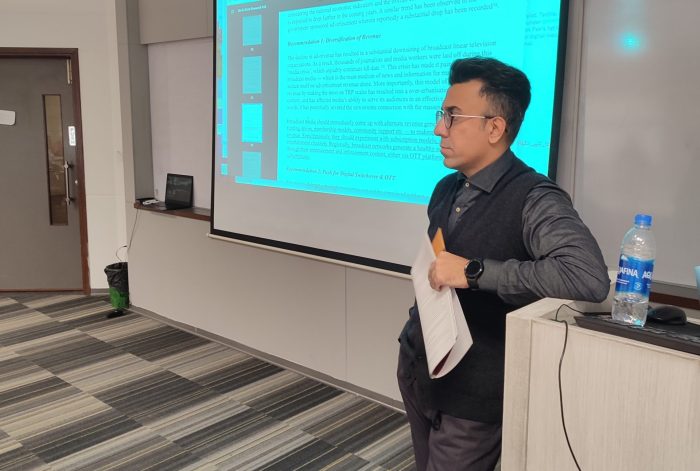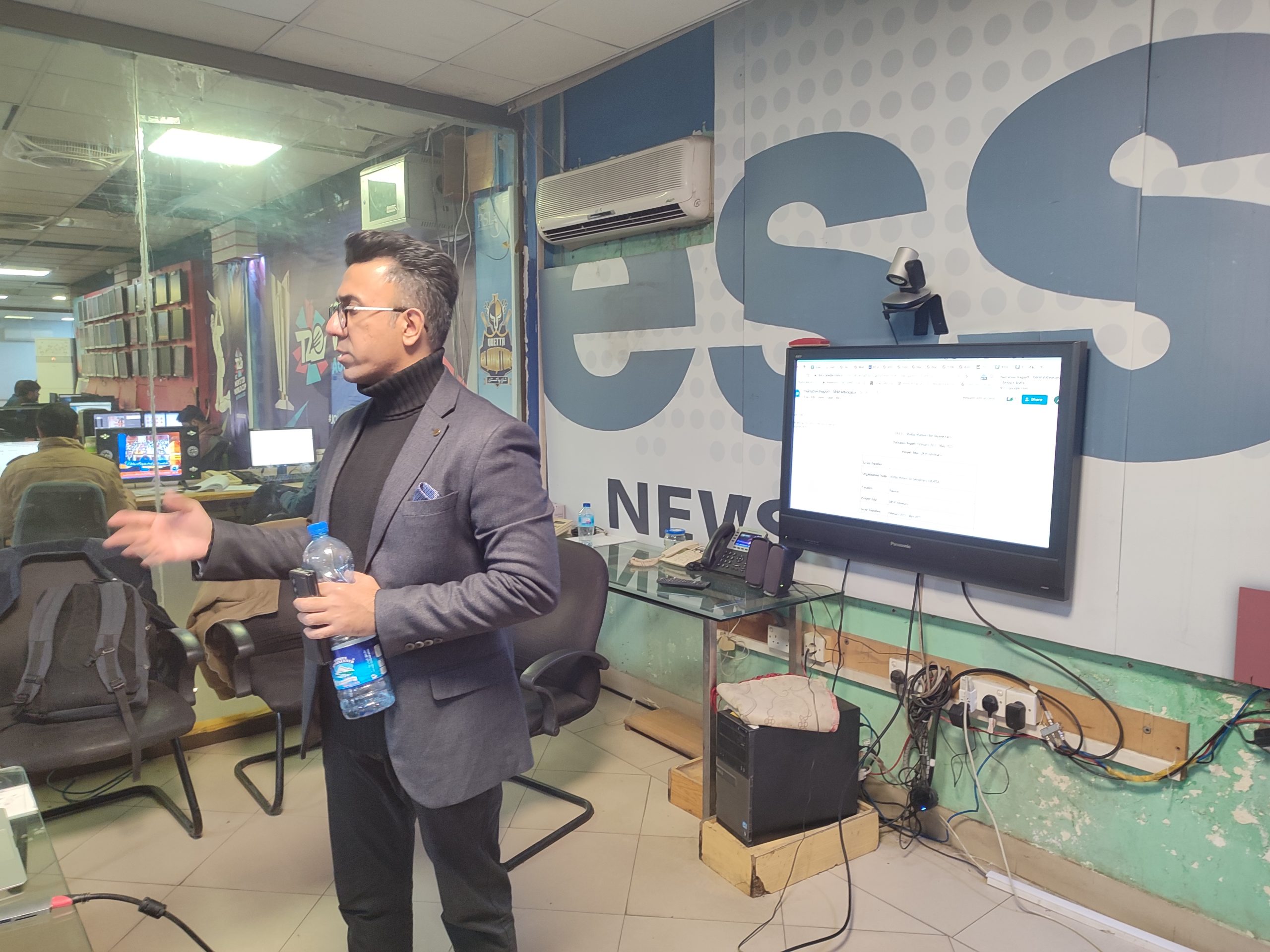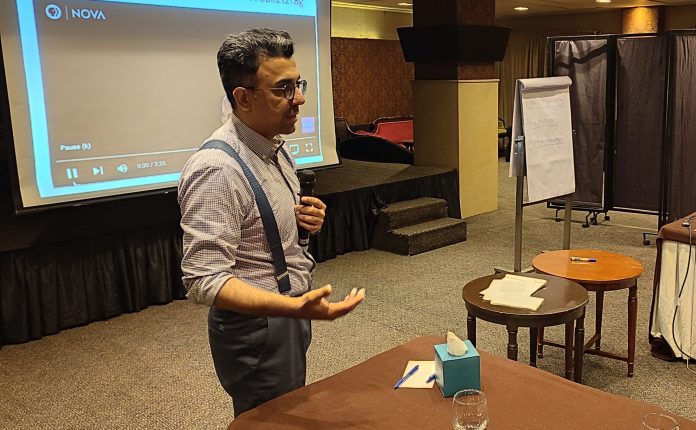Synergyzer: What are the primary objectives and outcomes of Media Matters for Democracy’s efforts to ensure that the media and public have the right tools and an enabling environment to exercise their fundamental rights and responsibilities?
Asad Baig: For the past eight years now, Media Matters of Democracy (MMfD) has been striving to ensure that the media and public alike get access to the right tools and an enabling environment so they can freely exercise their fundamental rights and professional duties.
When talking about restrictions on digital platforms, it is pertinent to understand that the mediums of free expression, such as Twitter, TikTok, Facebook, etc., are subject to multiple layers of regulations at different levels, be it the state-level censorships or interventions from the BigTechs themselves.
So, at times the tools are available and accessible, but when it comes to ensuring an enabling environment and liberty to use them, the challenge gets doubled. For example, Twitter is considered a global medium for free speech, however, the same is being used to bombard misinformation.
The MMfD’s scope of work mainly revolves around two main objectives. One is to ensure the traditional concept of free speech through advocacy, for example, awareness regarding PECA or lobbying for six new government policies in the past five years. Two, to lead, initiate and implement media information and literacy campaigns for stakeholders, in addition to creating awareness regarding the cons associated with tools of communication in order to make them conducive to free speech.
Synergyzer: How did you feel that there is a need for media training and development in Pakistan, and has the need been reduced since the inception of your organization? What are your key achievements?
Asad Baig: When it comes to disseminating information through media, gatekeeping holds much significance. However, unfortunately, nowadays, it’s done in an absurd way, mainly because of a lack of training of newsmen on the part of news organizations.
Media houses are doing cost cuttings, and the lack of trained human resources is becoming visible and quite evident. There seems to be no investment done for the capacity building of hired resources.
The consumption patterns and audience behaviors have changed over the past 7-8 years. However, not much has been done by media houses to gain insights on this behavioral change and subsequently do capacity building of newsroom staff to incorporate and align with this transformation. This is the major pain point that we are trying to address and resolve.
Over the years, Media Matters for Democracy has rolled out awareness and training programs aimed at making news persons key stakeholders in this equation. In addition to capacity building of individual journalists, MMfD has partnered with major newsrooms in Pakistan and trained their staff in-house through modules tailor-made to specific challenges and adaptative of their policies.
We initially observed that the newsrooms were not able to fully incorporate the transformation or practices suggested by a certain staff member trained externally, so we pivoted our strategy to achieve maximum results. This way, newsrooms have been more accepting of best practices for countering misinformation and digital fact-checking, and this has also allowed us to have more insight into the working mechanisms of the leading newsroom.

Synergyzer: Could you tell us about some of the significant challenges and opportunities in promoting media literacy and digital democracy in Pakistan and how Media Matters for Democracy addresses them?
Asad Baig: To garner insight and support for campaigns and initiatives, MMfD constantly conducts academic research on changing trends of media literacy and content consumption to ensure internal and external capacity building.
In our initial interaction, mostly the journalists inform us that they haven’t been aware of digital fact-checking. This is the main challenge we face working with journalists in the digital age who are not much aware of digital literacy. For media houses to offer this training, they don’t have enough budget and resources. Ideally, a separate team is needed to carry out research and in-house training activities.
In addition to this, the other pertinent challenge is that there are no set mechanisms in place to monitor and regulate misinformation in digital space. A case in point is the misinformation campaigns being carried out by political parties against their rivals.
For instance, the Election Commission of Pakistan (ECP) regulates the election and political campaigns, but only those done in physical space. But there are no set rules to either regulate or even monitor the extent of campaigns carried out in digital space. You cannot keep a check on troll farms and, subsequently, the misinformation content. Putting it in perspective, the whole electioneering scenario will be completely diametrical, if not volatile, in 2023, with not much in place to regulate.
Synergyzer: In your opinion, what are the current challenges and opportunities for independent journalism and media freedom in Pakistan, and how do Media Matters for Democracy contribute to addressing them?
Asad Baig: Not everything is in a worse state; the digital platforms are relatively independent, and digital media houses have considerably more freedom and liberty to operate as compared to conventional media houses.
However, the bigger challenge here is BigTech — the likes of Meta, Google, and similar others — who regulate the content to the extent of manipulation and censorship. For instance, we all are aware of the curbs implemented by the BigTech digital platforms regarding the Kashmir issue.
This new form of regulation is more dangerous, as there is still a complaint filing mechanism in place to contest restrictions imposed by the government. You can either move courts or appear before a tribunal to lodge a complaint against the state’s anti-freedom policies. But, on the contrary, there is no clear mechanism to address the censorship acts of BigTechs. Mostly you get a chatbot response from them, which doesn’t even answer your query properly. This remains the biggest threat to freedom of expression, as there is no clear picture to understand what level of stakeholders and players are behind these curbs.
Unfortunately, actual hate campaigns go unnoticed, but credible reporting platforms undergo continuous scrutiny.
Synergyzer: How do Media Matters for Democracy contribute to shaping correct narratives in light of providing and enabling responsible information?
Asad Baig: We need to have BigTech accountability. It’s not that those mediums are bad or anyone wants to ban those, however, they do need to offer certain accountability regarding their policies.
These platforms are continuously evolving and will take a natural course based on audience response and interactions, but they need to create some balance and offer a level playing field. We understand the importance of such social platforms, however, this one-sided approach towards content censorship is hampering access to means of freedom of speech. There needs to be a multi-stakeholder approach in order to ensure an enabling environment for the masses to exercise their rights.

Synergzer: What role does media literacy play in enhancing the effectiveness of media consumption?
Asad Baig: When you talk about regulating the masses, this is considered a resource blackhole. How will you ensure that the masses will consider information integrity?
When talking specifically about the Pakistani audience, there are a lot of fault lines i.e. religious, political, among others. Then there are economic issues having a considerable impact, generally a biased and charged crowd, and most recently, the behavior can be termed as that of a tussle between haves and have-nots.
In order to create information integrity, the masses need to be inoculated with misinformation. This process is similar to how a vaccination is administered to counter a virus; this is why the uncontrollable spread of misinformation is often referred to as infodemic.
Against every kind of misinformation, there needs to be a calculated and strategized inoculation of integral information so that the masses can eventually resist against the misinformation from within. But this requires great resources, which could not be possible to execute without the help of the government and state machinery.
The government does have budgets for media campaigns, but it generally doesn’t seem interested in spending it on educating the masses. Moreover, this will also mean creating awareness against misleading political campaigns, which no ruling party wants to do.
Media cannot be blamed for everything; they already have limited budgets in this ailing economy. The government needs to devise a multi-medium approach, much similar to the anti-polio campaign.
Misinformation is similar to a virus, and viruses cannot be inoculated at the production end but at the consumption end by improving immunity.
Synergyzer: Can you share any insights or lessons learned from your work at Media Matters for Democracy that could be valuable for political parties, candidates, and strategists interested in improving their branding efforts?
Asad Baig: It is a general perception that political campaigns utilize digital media platforms in an abusive manner. A few years back, we held a seminar in which senior representatives of all major political parties were present. There we asked them to share a commitment to ensure that their party platform will not be used to monger hate speech. But unfortunately, no political leader offered commitment that their party workers will not weaponize hate speech.
This is mainly because, generally, the party workers are utilized as loose cannons. Party leaders keep fueling them to garner support and strength and undermine their opponents. However, whenever a controversy occurs, they conveniently disown them.
So much similar to the government, no political party is interested in inoculating its workers. They have instead transformed certain segments into self-sustaining propaganda machines that will blindly accept and propagate any and every narrative.
The only way to resolve or limit this mutation effect is for segments of civil society to step up and put pressure on autonomous government bodies to take up awareness campaigns.
In addition to this, civil society groups can also run a sustained campaign on information integrity. Media space can be arranged under multiple categories through govt organizations like PEMRA, ECP, and others, who have dedicated budgets and slots for public awareness campaigns.

